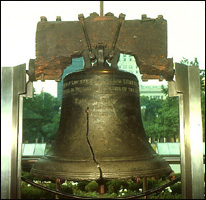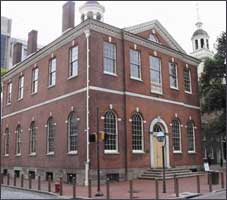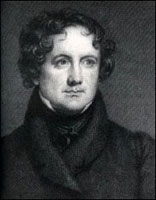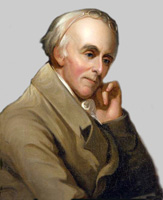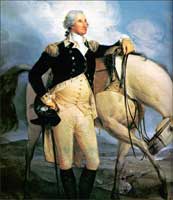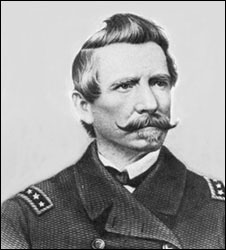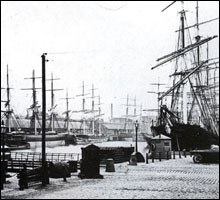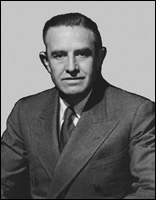AS OF 2016, THE BROWN BROTHERS HARRIMAN BANK HAD ASSETS OF $4.2 TRILLION!! |
On July 4, 1776, the New Jerusalem was reborn in the city of Philadelphia, Pennsylvania. That was the greatest day since October 31, 1517:
You have increased the nation O JEHOVAH, you have increased the nation, you are glorified: you have removed it far unto the ends of the earth (Isaiah 26:15).
The port city of Philadelphia was an excellent site for the new nation's capital because of its proximity to the sea, and midway between the northern and southern states.
|
Lucifer, Satan, or Apollyon was not standing idly by while the Jewish Messiah reestablished Israel in the Wilderness. A Supreme Court, a bank, and a "deadly" doctor were parting presents to the newborn Republic from Lord Conwallis.
|
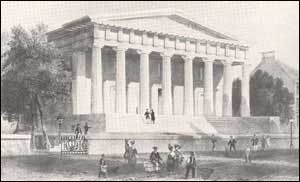 U.S. Bank headquarters in Philadelphia, Pennsylvania (circa 1836). |
Dr. Benjamin Rush of London and Philadelphia designed a chair to torture good King George III. He assisted thousands of the citizens of Philadelphia to meet their Maker.
|
That was the main reason why Philadelphia was abandoned as the new nation's capital, and a defenseless, malaria filled swamp named Washington City became the new capital. Nicholas Biddle and his fellow banksters were delighted with the move because elected government officials would not be looking over their shoulders.
Brown Brothers became the recipient of the funds of the defunct Second Bank of the United States
Brown Brothers Harriman & Co. (BBH) is the oldest and one of the largest private bank in the United States. In 1931, the merger of Brown Brothers & Co. (founded in 1818) and Harriman Brothers & Co. formed the current BBH. Assets Under Custody $4.2 trillion, September 30, 2016.
Brown Brothers Harriman was started by British Secret Service agent named Alexander Brown, and his son William, who was later knighted by Queen Victoria.
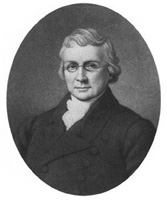 Alexander Brown (1764–1834). |
|
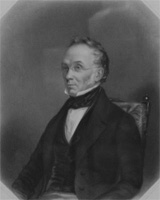 "Sir" William Brown (1784–1864). |
Bank of England moneychanger Brown prospered mightily in Baltimore. In 1818, Brown's son William opened a branch in Philadelphia, because that was the HQ of the Second Bank of the United States, which had its charter renewed in 1816.
 U.S. Bank HQ in Philadelphia, Pennsylvania (circa 1836). |
|
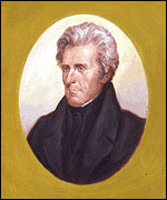 Andrew Jackson President from 1829 to1837. |
After the corrupt bank was shut down, Israel in the Wilderness expanded at a fantastic pace, and by 1848 it reached from sea to shining sea.
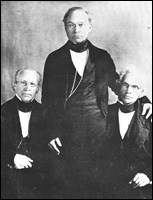 Partners in crime: John, James, and George Brown. |
|
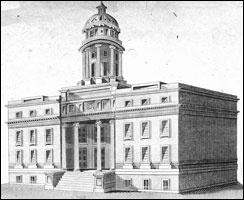 The Merchant's Exchange Bldg was the forerunner of the New York Stock Exchange. |
From that time onward, New York City began to replace Baltimore and Philadelphia as the leading port in the new and growing nation. With the opening of the Erie Canal in 1825, that dominant position was guaranteed.
Brown Brothers financed the rebels and built the Confederate raiders in Liverpool
During the Civil War, the Brown Brothers Bank financed the rebels, and their branch in Liverpool built the fearsome CSS Alabama commerce raider.
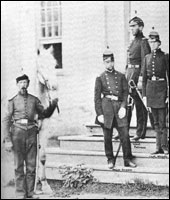 Major Clarence Brown (1835–1875), second from left. |
|
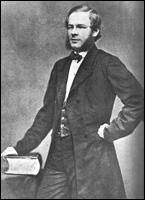 John Crosby Brown (1938–1909) was the bank's liaison in Liverpool. |
The company branch in Liverpool was called Brown, Shipley and Company. It's CEO was "Sir" William Brown.
|
Rebel spymaster James D. Bulloch was another employee of Brown, Shipley & Company. His sister Martha was the mother of President Theodore Roosevelt.
The Gilded Age robber barons were financed by the Brown Brothers Bank
Mark Twain called the time after the Civil War the Guilded Age. It was a time of unprecedented economic growth and massive Roman Catholic immigration from Europe. It was also the time that the robber barons created huge industrial combines.
 Andrew Carnegie (1835–1919). |
|
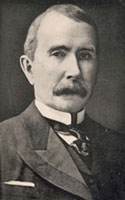 John D. Rockefeller (1839–1937). |
By 1911, the Standard Oil Company was a colossus, so the Supreme Court ordered that the company be dissolved into 34 divisions. The octopus was broken up, but all the division still banked with Brown Brothers. 2 of the divisions later became Standard Oil of New Jersey (Esso), and Standard Oil of New York ( Mobil). Those 2 companies later merged and became known as ExxonMobil
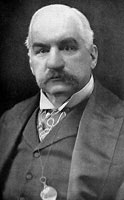 J. P Morgan (1837–1913). |
|
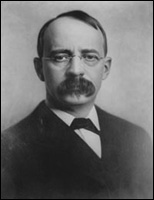 Edward Henry Harriman (1948–1909). |
A lesser known robber baron was a railroad tycoon named Edward Henry Harriman. By being discreet, he was able to keep his nefarious financial misdeeds out of the newspapers.
Brown Brothers became Brown Brothers Harriman in 1931
It was right after the beginning of the Great Depression that Brown Brothers merged with the Harriman railroad empire.
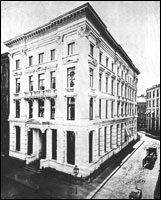 1529 Walnut St. was Brown Brothers HQ in Philadelphia. |
|
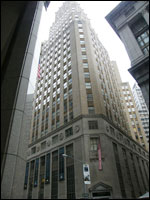 59 Wall St. was the HQ of Brown Brothers Harriman. |
While the rest of the nation was suffering from the dire effects of the Great Depression, the new bank prospered because real estate could be purchased cheaply. They already owned Pennsylvania, so they added Arkansas and West Virginia to their portfolios.
|
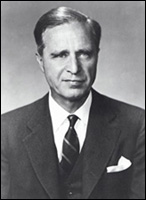 Prescott Bush (1895–1972). |
Germany was flat broke after WWI, and they were forced to pay huge war reparations to France. Miraculously, when Hitler came to power, money seemed to grow on trees. Prescott Bush was the bank's liaison with Nazi Germany . . . and he carried out his duties with great enthusiasm.
Averell Harriman financed the Presidential campaign of his daughter Hillary Clinton
Averell Harriman first met courtesan Pamela Churchill in 1941, when he was working to enlist the U.S. as an ally of Britain against Winston's cousin Adolf Hitler.
Pamela got pregnant in April 1946, and then she sailed to New York to have the baby. Amazingly, the baby was adopted by a couple named Hugh and Dorothy Rodham, who lived in Scranton, Pennsylvania. Scranton Pennsylvania just happens to be a Jesuit stronghold.
Hugh and Dorothy then handed baby Hillary over to their son Hugh, and his wife Dorothy, who lived in Chicago, Illinois. 3 years later the Rodhams had enough money to buy a house in an upscale suburb named Park Ridge.
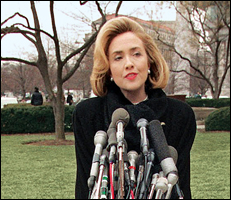 First Lady Hillary Clinton in 1997. |
|
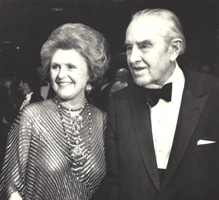 Pamela and Averell Harriman in 1981. |
Right after the '92 "election," the Clintons visited Pamela's Georgetown mansion to thank her for putting them in the White House.
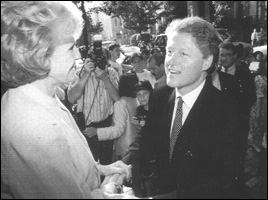 A grateful Bill shaking the hand of his mother-in-law. |
|
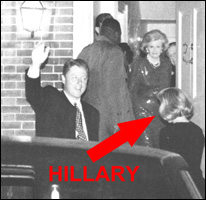 The grateful Clintons visiting Pamela after the election in Nov. '92. |
At that time, Pamela and Hillary realized that the job was only half done when Bill was President and Hillary was just First Lady. Both of them knew that Brown Brothers Harriman had enough "filty lucre" to reverse the roles, and make Hillary the first female President.
Vital links
References
Abramson, Rudy. Spanning the Century: The Life of W. Averell Harriman, 1891–1986. William Morrow & Co., New York, 1992.
Baker, Russ. Family of Secrets: The Bush Dynasty, America's Invisible Government, and the Hidden History of the Last Fifty Years. Bloomsbury Press, New York, 2009.
Kouwenhoven, John A. Partners in Crime: A Historical Portrait of a Great Private Bank Brown Brothers Harriman & Co., 1818–1968. Doubleday & Co., New York, 1968.
Ogden, Christopher. Life of the Party: The Biography of Pamela Digby Churchill Hayward Harriman. Little Brown & Company, Boston, 1994.
Smith, Sally Bedell. Reflected Glory: The Life of Pamela Churchill Harriman. Simon & Schuster, New York, 1996.
